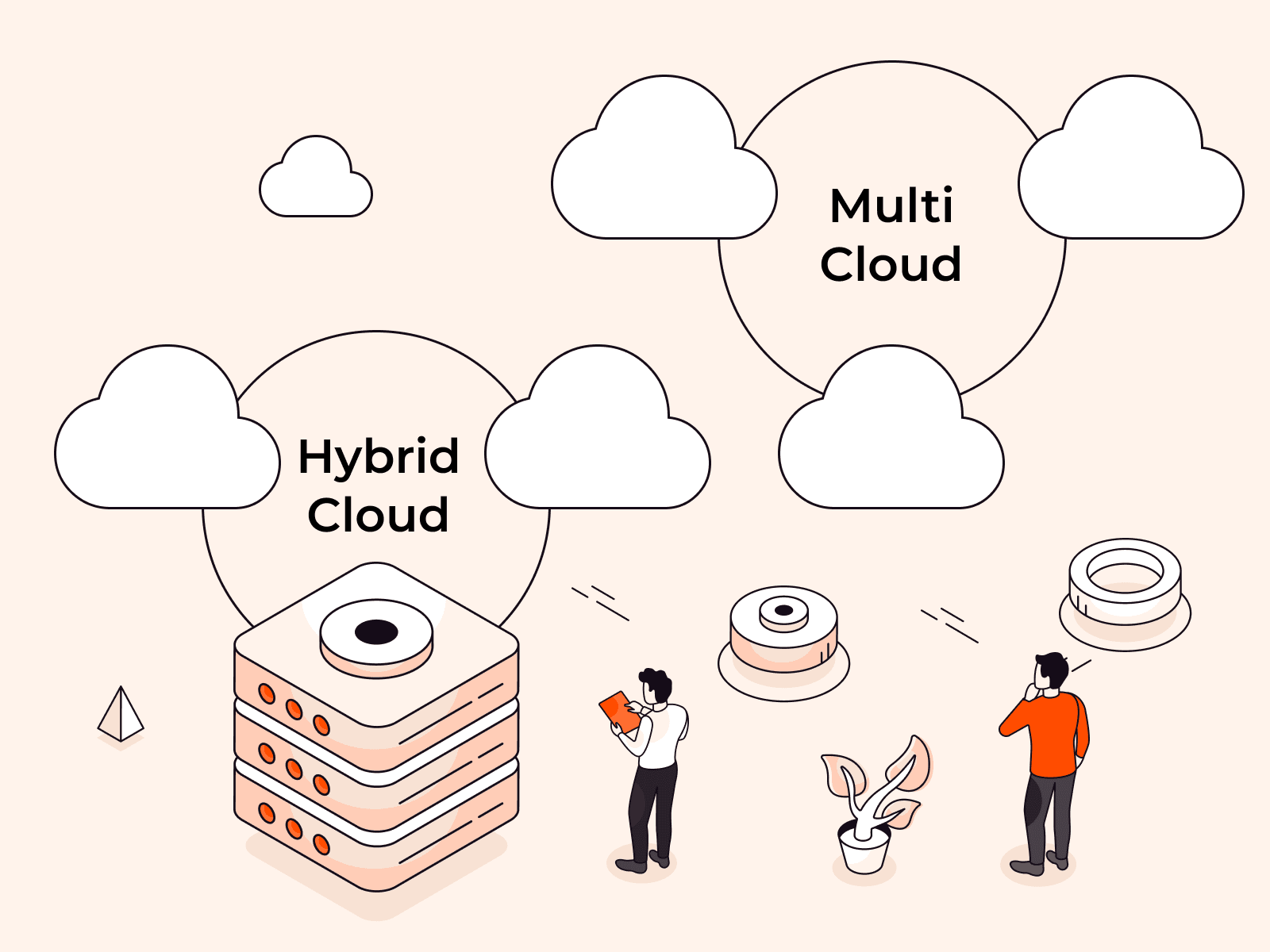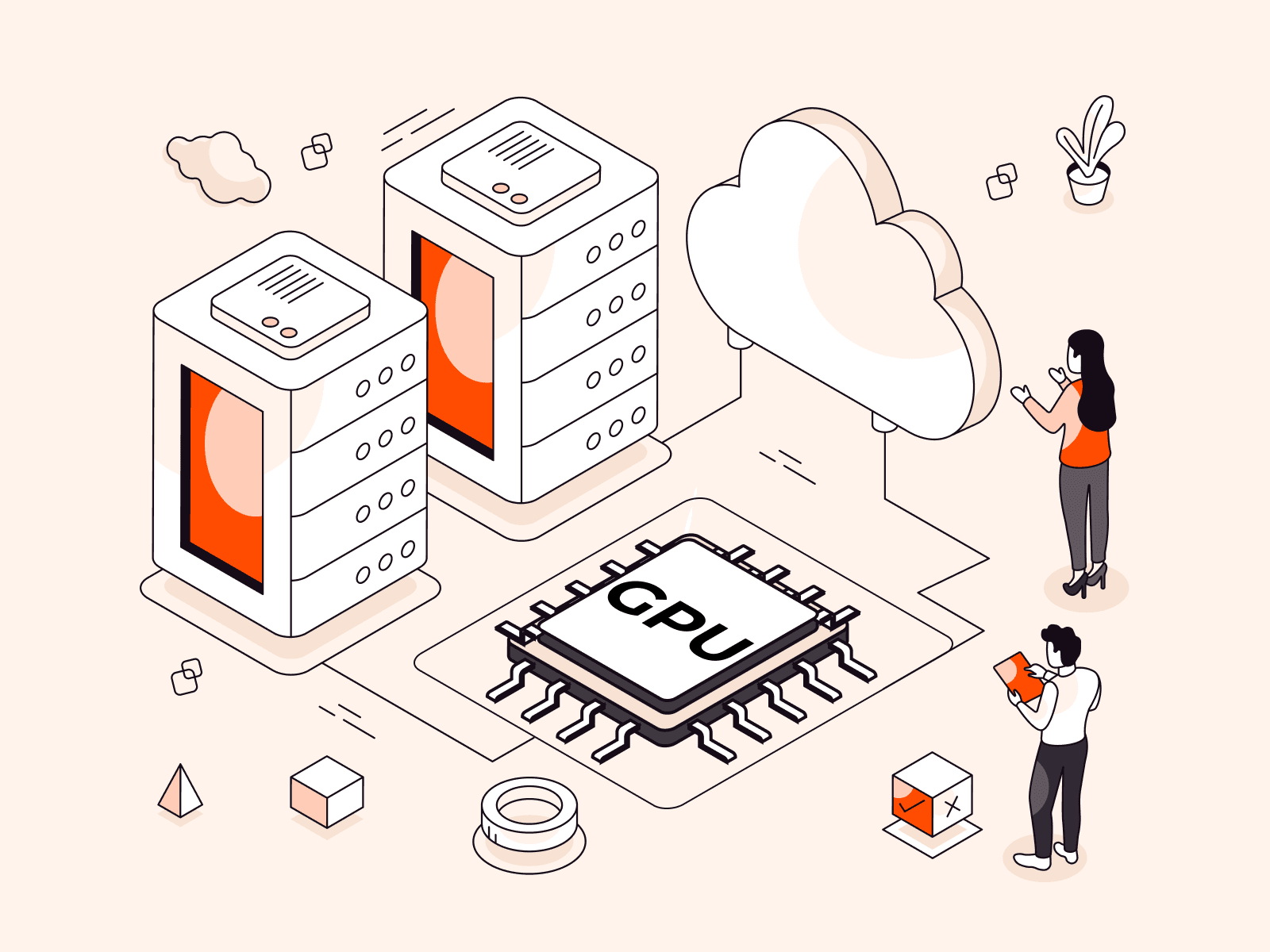What is cloud networking: benefits, components, and implementation strategies
- By Gcore
- October 1, 2025
- 8 min read

Cloud networking is the use and management of network resources, including hardware and software, hosted on public or private cloud infrastructures rather than on-premises equipment. Over 90% of enterprises are expected to adopt cloud networking solutions by 2025, indicating rapid industry-wide adoption for IT infrastructure modernization.
Cloud networking operates through advanced technologies that separate traditional hardware dependencies from network management. Software-Defined Networking (SDN) serves as a core technology, decoupling network control from hardware to allow centralized, programmable management and automation of network configurations.
This approach enables organizations to manage their entire network infrastructure through software interfaces rather than physical device manipulation.
The main components of cloud networking include several key elements that work together to create flexible network environments. Virtual Private Clouds (VPCs) provide isolated virtual network environments within the cloud, allowing organizations to define IP ranges, subnets, and routing for enhanced security and control. Virtual network functions (VNFs) replace traditional hardware devices like firewalls, load balancers, and routers with software-based equivalents for easier use and improved flexibility.
Cloud networking delivers significant advantages that transform how organizations approach network infrastructure management.
These solutions can reduce network operational costs by up to 30% compared to traditional on-premises networking through reduced hardware requirements, lower maintenance overhead, and improved resource use. Cloud networks can scale bandwidth and compute resources within seconds to minutes, demonstrating superior agility compared to traditional manual provisioning methods.
Understanding cloud networking has become essential for modern businesses seeking to modernize their IT infrastructure and improve operational effectiveness. This technology enables organizations to build more flexible and cost-effective network solutions that adapt quickly to changing business requirements.
What is cloud networking?
Cloud networking is the use and management of network resources through virtualized, software-defined environments hosted on cloud infrastructure rather than traditional on-premises hardware. This approach uses technologies like Software-Defined Networking (SDN) to separate network control from physical devices, allowing centralized management and programmable automation of network configurations. Virtual Private Clouds (VPCs) create isolated network environments within the cloud. In contrast, virtual network functions replace traditional hardware like firewalls and load balancers with flexible software alternatives that can scale within seconds to meet changing demands.
How does cloud networking work?
Cloud networking works by moving your network infrastructure from physical hardware to virtualized, software-defined environments hosted in the cloud. Instead of managing routers, switches, and firewalls in your data center, you access these network functions as services running on cloud platforms.
The core mechanism relies on Software-Defined Networking (SDN), which separates network control from the underlying hardware. This means you can configure, manage, and modify your entire network through software interfaces rather than physically touching equipment.
When you need a new subnet or firewall rule, you simply define it through an API or web console, and the cloud platform instantly creates the virtual network components.
Virtual Private Clouds (VPCs) form the foundation of cloud networking by creating isolated network environments within the shared cloud infrastructure. You define your own IP address ranges, create subnets across different availability zones, and set up routing tables exactly like you would with physical networks. The difference is that all these components exist as software abstractions that can be modified in seconds.
Network functions that traditionally required dedicated hardware appliances now run as Virtual Network Functions (VNFs).
Load balancers, firewalls, VPN gateways, and intrusion detection systems all operate as software services that you can use, scale, or remove on demand. This approach can reduce network operational costs by up to 30% compared to traditional on-premises networking while providing the flexibility to scale bandwidth and compute resources within seconds to minutes.
What are the main components of cloud networking?
The main components of cloud networking refer to the key technologies and services that enable network infrastructure to operate in virtualized cloud environments. They are listed below.
- Software-defined networking (SDN): SDN separates network control from hardware devices, allowing centralized management through software controllers. This approach enables automated network configuration and policy enforcement across cloud resources.
- Virtual private clouds (VPCs): VPCs create isolated network environments within public cloud infrastructure, giving organizations control over IP addressing, subnets, and routing. They provide secure boundaries between different workloads and applications.
- Virtual network functions (VNFs): VNFs replace traditional hardware appliances like firewalls, load balancers, and routers with software-based alternatives. These functions can be deployed quickly and scaled on demand without physical hardware constraints.
- Cloud load balancers: These distribute incoming network traffic across multiple servers or resources to prevent overload and maintain performance. They automatically adjust traffic routing based on server health and capacity.
- Network security services: Cloud-native security tools include distributed firewalls, intrusion detection systems, and encryption services that protect data in transit. These services combine directly with cloud infrastructure for consistent security policies.
- Hybrid connectivity solutions: VPN gateways and dedicated network connections link on-premises infrastructure with cloud resources. These components enable secure data transfer between different network environments.
- Network monitoring and analytics: Real-time monitoring tools track network performance, bandwidth usage, and security events across cloud infrastructure. They provide visibility into traffic patterns and help identify potential issues before they affect users.
What are the benefits of cloud networking?
The benefits of cloud networking refer to the advantages organizations gain when they move their network infrastructure from physical hardware to virtualized, cloud-based environments. The benefits of cloud networking are listed below.
- Cost reduction: Cloud networking eliminates the need for expensive physical hardware like routers, switches, and firewalls. Organizations can reduce network operational costs by up to 30% compared to traditional on-premises networking through reduced maintenance, power consumption, and hardware replacement expenses.
- Instant flexibility: Cloud networks can scale bandwidth and compute resources within seconds to minutes based on demand. This flexibility allows businesses to handle traffic spikes during peak periods without over-provisioning resources during normal operations.
- Centralized management: Software-Defined Networking (SDN) enables administrators to control entire network infrastructures from a single dashboard. This centralized approach simplifies configuration changes, policy enforcement, and troubleshooting across distributed locations.
- Enhanced security: Virtual Private Clouds (VPCs) create isolated network environments that prevent unauthorized access between different applications or tenants. Cloud networking achieves compliance with strict standards like GDPR and HIPAA through built-in encryption and access controls.
- High availability: Cloud providers maintain network uptime SLAs of 99.99% or higher through redundant infrastructure and automatic failover mechanisms. This reliability exceeds what most organizations can achieve with on-premises equipment.
- Reduced complexity: Network-as-a-Service (NaaS) models eliminate the need for specialized networking staff to manage physical infrastructure. Organizations can focus on their core business while cloud providers handle network maintenance and updates.
- Global reach: Cloud networking enables instant use of network resources across multiple geographic regions. This global presence improves application performance for users worldwide without requiring physical infrastructure investments in each location.
What's the difference between cloud networking and traditional networking?
Cloud networking differs from traditional networking primarily in infrastructure location, resource management, and flexibility mechanisms. Traditional networking relies on physical hardware like routers, switches, and firewalls installed and maintained on-premises, while cloud networking delivers these functions as virtualized services managed remotely through cloud platforms.
Infrastructure and management approaches
Traditional networks require organizations to purchase, install, and configure physical equipment in data centers or office PoPs. IT teams must handle hardware maintenance, software updates, and capacity planning manually.
Cloud networking operates through software-defined infrastructure where network functions run as virtual services. Administrators manage entire network configurations through web interfaces and APIs, enabling centralized control across multiple locations without physical hardware access.
Flexibility and speed
Traditional networking scales through hardware procurement processes that often take weeks or months to complete. Adding network capacity requires purchasing equipment, scheduling installations, and configuring devices individually.
Cloud networks scale instantly through software provisioning, allowing organizations to add or remove bandwidth, create new network segments, or use security policies in minutes. This agility enables businesses to respond quickly to changing demands without infrastructure investments.
Cost structure and resource allocation
Traditional networking involves significant upfront capital expenses for hardware purchases, plus ongoing costs for power, cooling, and maintenance staff. Organizations must estimate future capacity needs and often over-provision to handle peak loads.
Cloud networking operates on pay-as-you-go models where costs align with actual usage. According to industry case studies (2024), cloud networking can reduce network operational costs by up to 30% compared to traditional on-premises networking through improved resource effectiveness and reduced maintenance overhead.
What are common cloud networking use cases?
Common cloud networking use cases refer to the specific scenarios and applications in which organizations use cloud-based networking solutions to meet their infrastructure and connectivity needs. Below are some common cloud networking use cases.
- Hybrid cloud connectivity: Organizations connect their on-premises infrastructure with cloud resources to create cooperative hybrid cloud environments. This approach allows companies to maintain sensitive data locally while using cloud services for flexibility.
- Multi-cloud networking: Businesses distribute workloads across multiple cloud providers to avoid vendor lock-in and improve redundancy. This plan enables organizations to choose the best services from different providers while maintaining consistent network policies.
- Remote workforce enablement: Companies provide secure network access for distributed teams through cloud-based VPN and zero-trust network solutions. These implementations support remote work by ensuring employees can safely access corporate resources from any location.
- Application modernization: Organizations migrate legacy applications to cloud environments while maintaining network performance and security requirements. Cloud networking supports containerized applications and microservices architectures that require flexible connectivity.
- Disaster recovery and backup: Businesses replicate their network infrastructure in the cloud to ensure continuity during outages or disasters. Cloud networking enables rapid failover and recovery processes that reduce downtime and data loss.
- Global content delivery: Companies distribute content and applications closer to end users through cloud-based edge networking solutions. This approach reduces latency and improves user experience for geographically dispersed audiences.
- Development and testing environments: Teams create isolated network environments in the cloud for application development, testing, and staging. These environments can be quickly provisioned and torn down without affecting production systems.
How to implement a cloud networking strategy
You implement a cloud networking plan by defining your network architecture requirements, selecting appropriate cloud services, and establishing security and connectivity frameworks that align with your business objectives.
First, assess your current network infrastructure and identify which components can move to the cloud. Document your existing bandwidth requirements, security policies, and compliance needs to establish baseline requirements for your cloud network design.
Next, design your Virtual Private Cloud (VPC) architecture by defining IP address ranges, subnets, and routing tables. Create separate subnets for different application tiers and establish network segmentation to isolate critical workloads from less sensitive traffic. We can assist you with that, have a look at our virtual private cloud services.
Then, establish connectivity between your on-premises infrastructure and cloud resources through VPN connections or dedicated network links. Configure hybrid connectivity to ensure cooperation communication while maintaining security boundaries between environments.
After that, use Software-Defined Networking (SDN) controls to centralize network management and enable automated configuration changes. Set up network policies that can flexibly adjust bandwidth allocation and routing based on application demands.
Configure cloud-native security services, including network access control lists, security groups, and distributed firewalls. Apply the principle of least privilege by restricting network access to only necessary ports and protocols for each service.
Use network monitoring and analytics tools to track performance metrics like latency, throughput, and packet loss. Establish baseline performance measurements and set up automated alerts for network anomalies or capacity thresholds.
Finally, create disaster recovery and backup procedures for your network configurations. Document your network topology and maintain version control for configuration changes to enable quick recovery during outages.
Start with a pilot using non-critical workloads to validate your network design and performance before migrating mission-critical applications to your new cloud networking environment.
Learn more about building a faster, more flexible network with Gcore Cloud.
Frequently asked questions
What's the difference between cloud networking and SD-WAN?
Cloud networking is a broad infrastructure approach that virtualizes entire network environments in the cloud. At the same time, SD-WAN is a specific technology that connects and manages multiple network locations through software-defined controls. Cloud networking includes virtual networks, security services, and compute resources hosted by cloud providers, whereas SD-WAN focuses on connecting branch offices, data centers, and cloud resources through intelligent traffic routing and centralized management.
Is cloud networking secure?
Yes, cloud networking is secure when properly configured, offering advanced security features like encryption, network isolation, and centralized access controls. Major cloud providers maintain 99.99% uptime SLAs and comply with strict security standards, including GDPR and HIPAA, through technologies like Virtual Private Clouds that isolate network traffic.
How much does cloud networking cost compared to traditional networking?
Cloud networking costs 20-40% less than traditional networking due to reduced hardware expenses, maintenance, and staffing requirements. Organizations save on upfront capital expenditures while gaining predictable monthly operational costs through subscription-based cloud services.
How does cloud networking affect network performance?
Cloud networking can both improve and reduce network performance depending on your specific setup and requirements.
Cloud networking typically improves performance through global content delivery networks that reduce latency by 40-60%, automatic growing that handles traffic spikes within seconds, and advanced routing that optimizes data paths. However, performance can decrease if you're moving from a well-optimized local network to a poorly configured cloud setup, or if your applications require extremely low latency that adds overhead from internet routing and virtualization layers.
What happens if cloud networking services experience outages?
Cloud networking outages cause service disruptions, including loss of connectivity, reduced application performance, and potential data access issues lasting from minutes to several hours. Most major cloud providers maintain 99.99% uptime guarantees and use redundant systems to reduce outage impact through automatic failover to backup infrastructure.
Related articles
Subscribe to our newsletter
Get the latest industry trends, exclusive insights, and Gcore updates delivered straight to your inbox.





